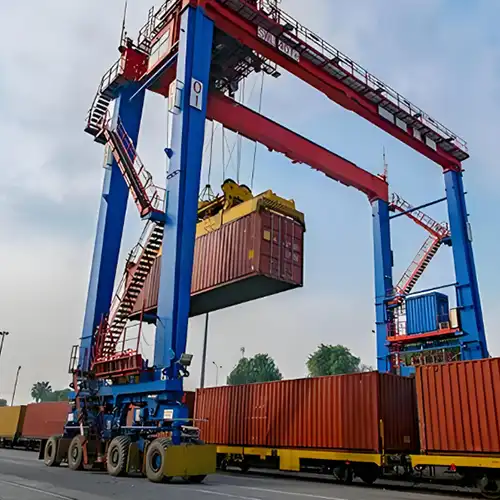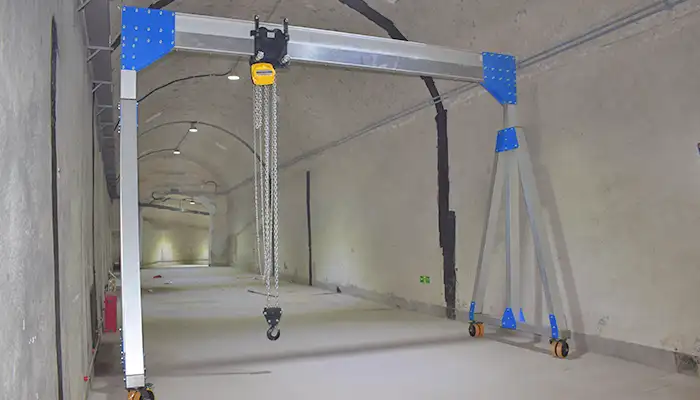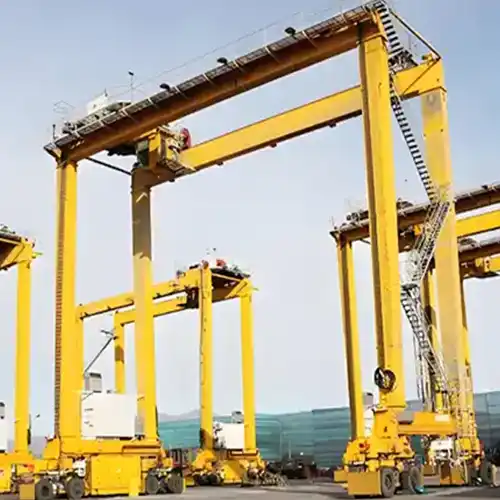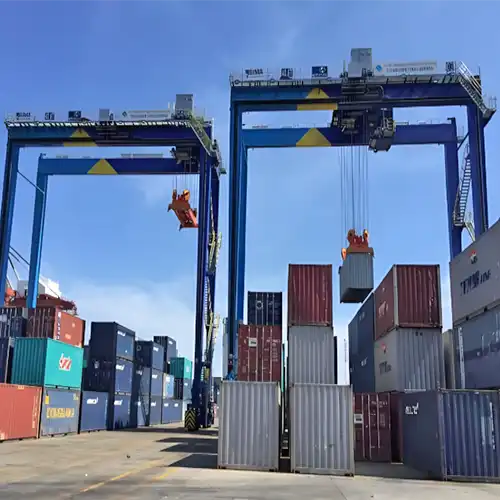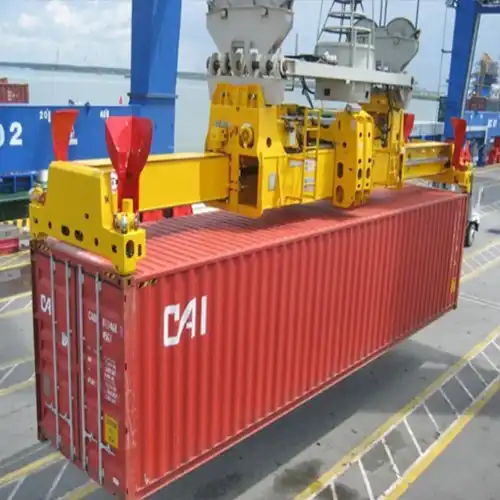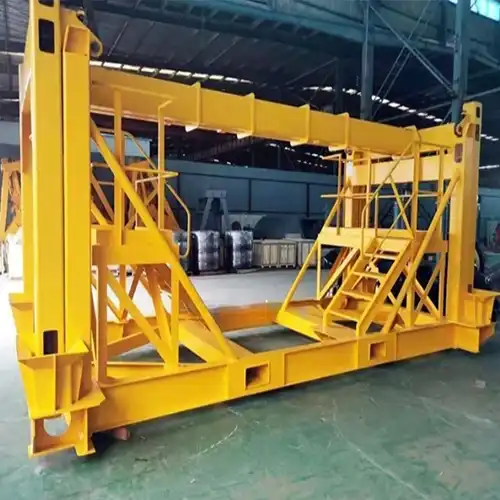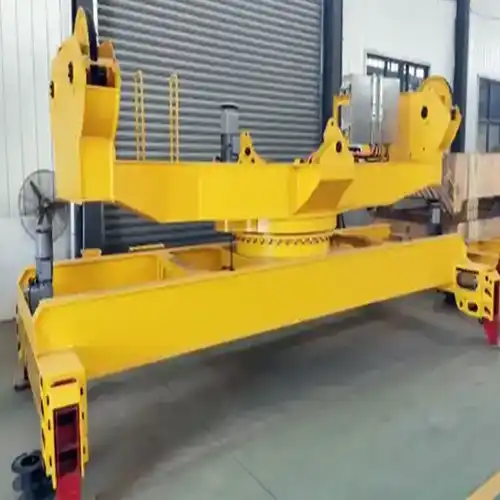RTG Crane, Your Rubber Tyred Gantry Crane Low Cost
Low crane cost RTG cranes is result of years rtg crane fabrication, wide rubber tyred gantry crane specifications at reasonable price for you.
| Crane Type | Rubber tyred gantry crane |
| Crane Capacity | 30 ton ~50 ton |
| Crane Span | 22~28m |
| Operating temperature | -20℃~40℃ |
Category: Gantry Crane
Your Trusted RTG Gantry Crane Manufacturer & Supplier
Rubber Tyred Gantry Crane & RTG Crane
Concrete Beam, Marble, Container & Large Loads Handlig
A rubber-tyred gantry crane (RTG) or transtainer is a wheeled mobile gantry crane used to ground or stack inter-modal containers. Outbound containers are stored for future loading into boats, while inbound containers are stored for future collection by drayage trucks. RTGs often travel across multiple lanes, with one lane allocated for container transfers. Its mobility provides a rubber-tyred gantry crane with a wide appliance.
RTG (Rubber Tyred Gantry) cranes are versatile and essential tools in modern material handling and logistics operations. These cranes are characterized by their ability to travel on rubber tires, which allows them to maneuver efficiently in diverse environments such as ports, warehouses, and construction sites.
Overview of RTG Cranes
RTG cranes are designed to lift and transport heavy loads with precision and speed. They typically feature a gantry structure that spans across a set of rubber tires, providing stability and mobility. This design enables them to handle containers, heavy equipment, and bulk materials with ease.
What is RTG crane? RTG crane is the short form of rubber tyred gantry crane which is a mobile gantry crane with rubber typred wheel used in intermodal operations to ground or stack containers. The rtg cranes are used to store the inbound containers for future pickup by drayage trucks, whereas the outbound containrs are stored by the rubber tyred gantry cranes for future loading onto vessels. RTG cranes typically straddle multiple lanes, with one lane reserved for container transfers.with the advantages of high mobiliety which enables a rubber tyred gantry crane with wide applications.
Importance in Material Handling and Logistics
RTG cranes play a crucial role in the logistics chain, particularly in container handling at ports. Their ability to stack containers vertically and move them across the storage yard facilitates efficient cargo operations. In industrial warehouses and construction sites, RTG cranes are used for loading and unloading materials, enhancing productivity and operational efficiency.
Main specifications of rubber tyred gantry cranes
- Capacity of rtg crane : 5 ton, 10 ton, 16 ton, 20 ton, 32 ton, 40.5ton, 50 ton, upto 500 ton
- Span of rtg crane: 18- 35 m
- Lifting height of rtg crane : 6- 12m
- Working duty of rtg crane : A3 - A5
Customized rubber tyred gantry crane specifications are available. Please feel free to contact us to get your customized rtg crane design today.
Working conditions of RTG Rubber Typred Gantry Crane
- The power source of RTG Rubber typred gantry craneis three phase current, rated frequency is 50 HZ and nominal voltage is 300v.
- The operating ambient temperature is approximately -20 to 45 degree centigrade, and the maximum relative humidity is no less than 95 percent.
- When operating the RTG cranes, the wind speed is not more than 20 m/s, on the contrary, it is not more than 44 m/s when RTG cranes aren't operated.
- The working grade of RTG Rubber typred gantry craneis A6 and A7.
- RTG Rubber typred gantry craneis suitable for spans of between five and eight containers wide, and for lifting height of 1 over 3 to 1 over 6 containers high.
- The surface slope of RTG Rubber typred gantry craneis less than 1 percent, and local slope is not more than 3 percent.
Key Features and Advantages
- Mobility: The rubber tires of RTG cranes allow them to navigate various terrains smoothly, from paved surfaces to gravel and uneven ground.
- Versatility: They can handle a wide range of loads, from standard containers to oversized or irregularly shaped items, making them adaptable to diverse operational needs.
- Precision Control: RTG cranes are equipped with advanced control systems that enable operators to maneuver loads with precision, minimizing risks of damage or accidents.
- Cost Efficiency: Compared to traditional fixed cranes, RTG cranes offer cost-effective solutions due to their mobility and ability to handle multiple tasks within a defined area.
- Space Optimization: By stacking containers vertically and utilizing vertical space efficiently, RTG cranes maximize storage capacity in container terminals and warehouses.
- Environmental Benefits: Some modern RTG cranes are designed with energy-efficient features, contributing to sustainability goals by reducing fuel consumption and emissions.
In summary, RTG cranes are indispensable assets in modern logistics and material handling operations, combining mobility, versatility, and efficiency to meet the dynamic demands of global supply chains.
RTG (Rubber Tyred Gantry) cranes are specialized gantry cranes equipped with rubber tires, designed for lifting and transporting heavy loads in various industrial and logistical applications. Unlike traditional fixed cranes, RTG cranes are mobile and can traverse across different surfaces, providing flexibility in material handling operations.
Advantages of Rubber Tyred Gantry Crane
- Cost-effective rgt crane solutions due to lower energy consumption
- Exceptional anti-sway performance, Smooth rgt crane operation,
- Accurate spreader positioning - no headblock - better visibility
- Rigid structure and anti-wind devices, better performance where high winds prevail
- Low maintenance downtimes, high efficiency and productivity.
Features of Rubber Tyred Gantry Cranes
- Rubber tired gantry crane is flexibly moved by its own Rubber tires for transshipping containers.
- wide application .Weihua Rubber tyred container gantry crane is equipped with specialized spreaders to lift standard-sized 20GP, 40GP, 45HQ containers and hydraulic storage tanks.
- The trolley and crane traveling mechanisms equip three-in-one reducer with convenient maintenance.
- The tires of this container gantry crane can rotate 90and move obliquely at 20 and 4
- 1 gantry drive per corner, Simultaneous drive motion, Direct driven travel systems
- RTGid robust structure
- Hoist ropes reeved directly to the telescopic spreader
- Gantry align steering
Rubber Tyred Gantry Cranes also called RTG cranes are used in particular for efficient stacking of standard containers, with similar funnction with the rail mounted gantry crane, whihc is a kind of container cranes.
According to different power supply, there are mainly two types of rubber tyred gantry crane,s the diesel engine-electric mode rtg cranes and diesel engine-hydraulic rtg cranes. Originally, RTG cranes were powered by diesel generator systems, however, there has been a clear trend towards the electrification of RTGs in recent years for the shutting down diesel generators is not only good for environment,by reducing overall fuel consumption but also may be a growing economic argument for port operatorsbecause the electric motor is easy to use and needs simple maintenance.
Hot Sale Types of Electric Motorized Rubber Tyred Gantry Crane
Rubber tyred gantry crane, also known as rubber tired gantry crane RTG crane is a kind of mobile device used for moving and stacking storage containers.
The rubber tyred single girder gantry crane is used together with the electric wire rope hoist, which runs on the main beam. Generally, the lifting weight is 3-20t, the span is 7-30m, and the working temperature is -20-40 degrees.With process crane design, Double girder rubber tyred gantry cranes are usually used for heavyier loads handling with capacity from 30 ton to 50 ton. Based on your applications and requirements, your tailored double girder rubber tyred gantry cranes are provided for your application.
A Frame Rubber Tyred Gantry Cranes
A Frame RTG cranes are characterized by their A-shaped gantry structure, which provides robust support and stability for various lifting operations. These cranes are available in two main configurations:
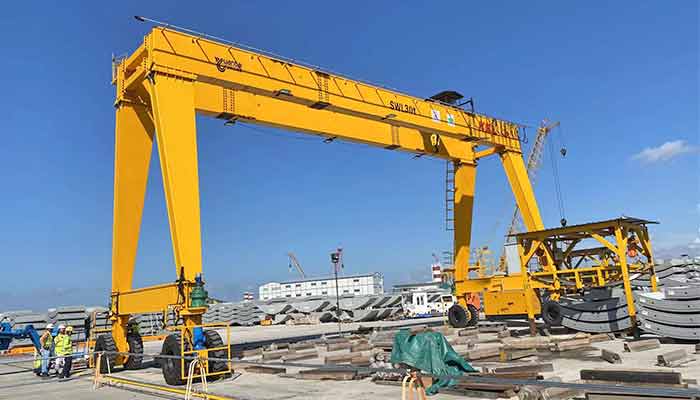
- Single Girder RTG Cranes: These cranes feature a single beam (girder) that supports the hoist and trolley mechanism. Single girder RTG cranes are suitable for applications requiring lighter to moderate lifting capacities. They are often chosen for their cost-effectiveness and compact design, making them ideal for operations where space is limited or where budget considerations are critical.
- Double Girder RTG Cranes: Double girder RTG cranes utilize two parallel girders running the length of the gantry. This design significantly enhances load capacity and stability, making them suitable for heavy-duty lifting tasks. Double girder RTG cranes are preferred in environments where precision and control over larger loads are essential. They offer increased strength and durability, making them well-suited for demanding industrial settings.

Single Girder Rubber Tyred Gantry Crane
Main parametrers of single girder rubber tyred gantry crane
- Lifting weight of rtg crane is 3-20t,
- Span of rtg crane 7-30m,
- Working temperature of rtg crane: -20-40 degrees.
- Operating temperature of rtg crane: -20℃~40℃
- Custom option are provided for your application.

Double Girder Rubber Tyred Gantry Crane
Rubber tired gantry crane parameters:
- Lifting capacity of rtg crane: 30t~50t
- Span lengthof rtg crane: 22~28m
- Lifting speed of rtg crane: 12~46m/min
- Crane speed of rtg crane: 45-90m/min
- Operating temperature of rtg crane: -20℃~40℃
- Custom option are provided for your application.
Key Features of A Frame RTG Cranes:
- Gantry Structure: The A-shaped gantry structure provides robust support and stability during lifting operations.
- Hoisting Mechanism: Equipped with either wire rope hoists or chain hoists depending on the specific application and load requirements.
- Mobility: Rubber tyred wheels allow for easy movement and positioning within the working area, providing flexibility in handling various loads.
- Control Systems: Advanced control systems ensure precise maneuverability and safety during operations.
- Customization: Can be customized with additional features such as anti-sway systems, remote control operation, and automation for improved efficiency.
Applications of A Frame RTG Cranes:
- Ports and Terminals: Handling containers and heavy cargo in port operations, ensuring efficient logistics and stacking.
- Construction Sites: Lifting and moving construction materials and equipment, facilitating construction processes and site management.
- Logistics and Warehousing: Managing storage and retrieval of goods in warehouses and distribution centers, optimizing space utilization and operational efficiency.
- Industrial Manufacturing: Supporting production lines by transporting heavy components and machinery, enhancing manufacturing processes.
A Frame RTG cranes offer versatile solutions across various industries, combining robust design with efficient performance to meet diverse lifting needs.
U Frame Rubber Tyred Gantry Cranes
Double Girder U Frame RTG Cranes: These cranes utilize a U-shaped gantry structure with two parallel girders running the length of the crane. This design enhances rigidity and strength, making them ideal for heavy lifting applications where stability and load-bearing capacity are critical. Double girder U Frame RTG cranes are commonly deployed in environments such as container terminals, steel mills, and heavy manufacturing facilities.

Double Girder Rubber Tyred Gantry Crane with U Frame
Double beam rubber gantry crane design provides increased stability and lifting capacity, which is suitable for heavier-duty applications.
- Lifting capacity:5-500t
- Span:5-30m
- Lifting height:6-30m
- Custom designs available
U Frame RTG cranes feature a U-shaped gantry structure, offering a unique structural configuration that provides specific advantages for various operational requirements:
Key Features and Advantages:
- Structural Design: The U Frame configuration inherently provides greater lateral stability and strength compared to other designs, ensuring reliable operation under heavy loads and adverse environmental conditions.
- Heavy-duty Capability: Designed for handling heavy containers, oversized machinery, and other large loads with precision and efficiency.
- Safety and Control: Dual girders support the hoisting mechanism, enhancing control and minimizing load sway during lifting and transportation operations. This feature improves operational safety and reduces the risk of accidents.
- Customization: Manufacturers offer customization options to tailor double girder U Frame RTG cranes to specific site conditions, operational needs, and safety regulations. This flexibility allows for optimal integration into diverse industrial settings.
Applications: Suitable for a wide range of industrial applications where robust performance and reliability are required, including:
- Container Terminals: Efficient handling and stacking of containers in port operations.
- Steel Mills: Moving heavy steel coils and materials within manufacturing facilities.
- Heavy Manufacturing: Transporting oversized equipment and components during production processes.
U Frame RTG cranes, particularly the double girder variant, combine structural strength with operational flexibility, making them a preferred choice for demanding material handling tasks across various industries. Their design ensures efficient performance and longevity in challenging operational environments.
Straddle Carrier Rubber Tyred Gantry Crane
A straddle carrier gantry crane, sometimes known as a straddle truck, is a freight-carrying vehicle that bears its load underneath by "straddling" it, rather than on top, as a typical truck does. The straddle carrier gantry crane has the benefit of being able to load and unload without the use of cranes or forklifts. The driver operates the lifting apparatus beneath the carrier without any outside aid and without leaving the driver's seat.

Straddle Carrier Rubber Tyred Gantry Crane

Straddle Carrier Rubber Tyred Gantry Crane
The straddle carrier gantry crane is a type of rubber tyre gantry crane lifting equipment with flexible and dynamic qualities and a lifting capacity of up to 1200 tons.
Specializations and Product Offerings
- Customization: Most manufacturers offer customizable RTG cranes tailored to specific operational environments, such as ports, warehouses, and construction sites. Customization options include load capacities, lifting heights, control systems, and environmental adaptations.
- Technology Integration: Leading manufacturers incorporate advanced technologies into their RTG cranes, such as automation, remote monitoring, and energy-efficient solutions. These features enhance operational efficiency, safety, and sustainability.
- Service and Support: Manufacturers provide comprehensive after-sales support, including maintenance services, spare parts availability, and training programs for crane operators and maintenance personnel.
- Global Presence: Many of the top RTG crane manufacturers have a global presence, with manufacturing facilities, service centers, and sales offices strategically located to support customers worldwide.
In summary, choosing an RTG crane involves considering the specific capabilities, specializations, and support services offered by leading manufacturers. Their expertise in designing and delivering reliable, high-performance RTG cranes ensures efficient material handling operations across diverse industrial sectors.
Applications and Industries of Rubber Tyred Gantry Cranes
What is the purpose of a rubber-tired gantry crane? Rubber tyred gantry cranes are most commonly employed at port terminals and intermodal yards for stacking and transferring ISO standard containers. The carrier straddles its load, picking it up and carrying it using a container spreader to attach to the top lifting points.
Some devices are capable of stacking containers up to four high. They travel at relatively moderate speeds (up to 30 km/h or 20 mph) while carrying a loaded container. The carrier's drivers sit sideways at the very top and face the middle, allowing them to view behind and in front of the vehicle. Straddle carrier gantry cranes have a lifting capacity of 60 t (59 long tons; 66 short tons), which is equivalent to two full containers.
- Bridge Projects -Handling rebar cages, lifting and storing of precast girders and casting plates, lifting and erection of precast bridge segment;
- Subway Tunnel -Remove the excavated residual soil, handling and transport concrete pipes, pipe fittings and heavy concrete aggregates, etc.
- Shipyard -Move, transfer, turnover ships from one place to another, help to maintenance, repair ships, etc.
- Jetty/Port, Manufacturing Factory, Storage Yard -Cargo/Goods handling, barge, etc, Lifting & handling heavy materials

Single girder rubber tyred gantry crane with wire rope hoist

Single girder rubber tyred gantry crane with wire rope hoist

Double girder rubber tyred gantry crane

Customized rubber tyred gantry cranes
RTG (Rubber Tyred Gantry) cranes are widely utilized across various industries due to their mobility, versatility, and capability to handle heavy loads. Here are the common industries where RTG cranes play a vital role:
Ports and Container Terminals
RTG cranes are indispensable in port operations, particularly in container terminals:
- Container Handling: They stack containers vertically in storage yards and facilitate the transfer of containers between trucks, trains, and ships. RTG cranes' mobility along rows of containers optimizes storage space and expedites vessel loading and unloading operations.
- Flexibility: Adaptability with various lifting attachments allows RTG cranes to handle different container sizes and types efficiently.
- Operational Efficiency: RTG cranes reduce congestion and turnaround times in ports, enhancing overall port throughput and logistics efficiency.
Industrial Warehouses
In large-scale industrial warehouses, RTG cranes enhance material handling operations:
- Bulk Material Handling: They move heavy materials like steel coils, pipes, and manufactured goods within warehouses.
- Storage Optimization: RTG cranes maximize vertical storage space by efficiently stacking pallets and containers, facilitating organized inventory management.
- Just-in-Time Manufacturing: Supporting just-in-time manufacturing principles, RTG cranes ensure timely delivery of materials to production lines, minimizing inventory costs.
Construction Sites
RTG cranes are essential in construction projects for various tasks:
- Material Delivery: They transport construction materials such as steel beams, concrete panels, and pre-fabricated components across sites.
- Heavy Lifting: RTG cranes handle heavy equipment and machinery during installation and assembly processes, supporting construction projects.
- Mobility on Site: Their rubber tires enable easy movement on uneven terrain, providing flexibility in positioning and operational efficiency.
Rail Yards
Container Handling RTG cranes contribute to efficient freight handling and maintenance operations in rail yards:
- Container Transfer: They facilitate the transfer of containers between railcars and storage areas, optimizing logistics flow within rail yards.
- Maintenance Support: RTG cranes assist in lifting and positioning heavy components during railcar maintenance and repair, ensuring safe and efficient operations.
- Space Utilization: Similar to ports, RTG cranes maximize space utilization in rail yards by organizing containers and goods effectively.
In summary, RTG cranes are integral across diverse industries, enhancing operational efficiency, optimizing logistics, and improving productivity in handling heavy materials and equipment. Their versatility and mobility make them essential in modern industrial and logistical environments, supporting critical operations from ports to construction sites and beyond.
Key Features and Components of Rubber Tyred Gantry Cranes
RTG (Rubber Tyred Gantry) cranes are engineered with specific features and components that enhance their functionality and operational efficiency in various industrial applications:
Structure and Design Elements
- Rubber Tyres for Mobility: RTG cranes are equipped with rubber tires that enable smooth movement across different surfaces, including paved roads, gravel, and uneven terrain. This mobility allows for flexible positioning and efficient material handling within industrial facilities such as ports, warehouses, and construction sites.
- Gantry Structure: The gantry structure of RTG cranes supports the lifting mechanism and ensures stability during lifting and movement operations. Constructed from robust steel beams and framework, it is designed to withstand heavy loads and environmental stresses.
Hoisting Mechanisms
- Hoisting System: RTG cranes employ electric hoists or hydraulic systems to lift and lower loads with precision. Integrated with the gantry structure, these mechanisms are equipped with hooks, spreader beams, or other attachments to securely hold and transport materials.
- Trolley System: A trolley mechanism allows horizontal movement of the hoist along the length of the crane beam or girder. This system facilitates precise positioning of loads during lifting and placement operations, enhancing operational flexibility and efficiency.
Control Systems
- Advanced Control Panels: Operated via advanced control panels located in the operator's cabin, RTG cranes feature intuitive interfaces and ergonomic controls. These panels enable operators to monitor crane functions, adjust operating parameters, and ensure safe and efficient handling of loads.
- Safety Features: RTG cranes incorporate integrated safety systems such as overload protection, emergency stop controls, and anti-collision devices. These features are designed to prevent accidents, protect personnel, and safeguard equipment during crane operations, adhering to industry standards for safe working practices.
Environmental Adaptability
- Weatherproof Design: RTG cranes are built to withstand various environmental conditions, including rain, wind, and temperature extremes. They are equipped with protective coatings and corrosion-resistant materials to prolong crane lifespan and minimize maintenance requirements in challenging environments.
- Energy Efficiency: Modern RTG cranes are designed with energy-efficient components and systems. Features like regenerative braking and variable speed drives optimize energy consumption, reducing operational costs over the crane's lifecycle while maintaining high performance.
In conclusion, RTG cranes integrate robust structural design, advanced hoisting mechanisms, precise control systems, and environmental adaptability to meet the rigorous demands of industrial material handling operations. These features ensure reliability, safety, and efficiency in handling heavy materials and improving logistics performance across diverse industries.
Performance and Specifications
RTG (Rubber Tyred Gantry) cranes are designed to deliver reliable performance and efficiency in material handling operations. Here's an overview of their key performance parameters and specifications:
Load Capacities and Lifting Heights
- Load Capacities: RTG cranes are available in a range of load capacities, typically starting from tens of tons and going up to several hundred tons. Manufacturers offer customization options to meet specific operational requirements, ensuring that the crane can handle varying load sizes and types effectively.
- Lifting Heights: The lifting height of RTG cranes is adjustable based on facility layout and operational needs. Standard lifting heights can range from a few meters to over 30 meters, allowing for efficient stacking and retrieval of containers or materials within storage yards or warehouses.
Operational Speeds and Efficiency
- Travel Speed: RTG cranes are designed for efficient movement across terminal or warehouse yards. Travel speeds typically range from 20 to 40 meters per minute, allowing for quick positioning and maneuverability between storage stacks or loading/unloading areas.
- Lifting and Trolley Speeds: The hoisting and trolley speeds of RTG cranes contribute to overall operational efficiency. Hoisting speeds can vary depending on load capacity but generally range from 10 to 25 meters per minute. Trolley speeds allow for precise positioning of loads and typically range from 40 to 120 meters per minute.
- Cycle Times: Efficient cycle times are crucial for optimizing container handling operations in ports and terminals. RTG cranes are engineered to minimize cycle times between container lifts and transfers, enhancing productivity and throughput rates.
Environmental Considerations
- Weather Resistance: RTG cranes are designed to withstand various weather conditions, including rain, wind, and temperature extremes. Weatherproofing measures such as protective coatings on structural components and electrical systems ensure reliable performance and longevity in outdoor environments.
- Corrosion Protection: Corrosion-resistant materials and coatings are applied to critical components of RTG cranes exposed to maritime environments or industrial atmospheres. These measures prevent rust and deterioration, reducing maintenance requirements and extending crane lifespan.
- Energy Efficiency: Modern RTG cranes are equipped with energy-efficient components and systems, such as regenerative braking and variable frequency drives. These technologies optimize energy consumption during crane operations, reducing operational costs and environmental impact.
Safety Features
- Overload Protection: Integrated overload detection systems prevent exceeding the crane's maximum lifting capacity, ensuring safe lifting operations and protecting personnel and equipment from accidents.
- Emergency Stop Controls: Emergency stop buttons and safety interlocks enable immediate halting of crane operations in emergency situations, mitigating risks and enhancing workplace safety.
- Anti-Collision Systems: Advanced anti-collision systems use sensors and automation to prevent collisions between RTG cranes and other equipment or structures within the operational area, maintaining safe working environments.
In summary, RTG cranes are designed with robust performance capabilities, efficient operational speeds, and comprehensive safety features to meet the demanding requirements of container terminals, industrial warehouses, and other material handling environments. Their environmental adaptability and energy-efficient technologies contribute to sustainable operations and enhanced productivity across diverse industries.
Cost Considerations
RTG (Rubber Tyred Gantry) cranes vary in price based on several factors that influence their overall cost-effectiveness and operational efficiency. Here are the key considerations:
Factors Influencing RTG Crane Prices
Size and Capacity
- Load Capacity: The load capacity of an RTG crane significantly impacts its price. Higher capacity cranes capable of lifting heavier loads command a higher price due to the robustness of their structural components and lifting mechanisms.
- Span and Lifting Height: Larger spans and higher lifting heights increase material and engineering requirements, contributing to higher manufacturing costs and, consequently, a higher purchase price.
Customization Requirements
- Special Features: Customization options such as specialized lifting attachments, advanced control systems, and environmental adaptations (e.g., weatherproofing, corrosion protection) add to the base cost of an RTG crane.
- Operational Integration: RTG cranes tailored to integrate with existing infrastructure or specific operational needs may require additional engineering and design efforts, impacting overall pricing.
Maintenance and Operational Costs
- Maintenance Requirements: The design complexity and component durability affect maintenance costs. Cranes with robust, reliable components and ease of maintenance may have lower lifecycle maintenance costs compared to those with intricate designs or specialized components.
- Operational Efficiency: Energy-efficient features and automation technologies can reduce operational costs over time by minimizing energy consumption and optimizing crane performance.
Manufacturer and Supplier Pricing Policies
- Market Position: Leading manufacturers may command premium prices based on their reputation, reliability, and technological advancements in RTG crane design and manufacturing.
- Service and Support: Manufacturers offering comprehensive after-sales support, including maintenance services, spare parts availability, and operator training, may influence initial purchase decisions based on long-term operational benefits.
Total Cost of Ownership (TCO)
When evaluating RTG crane investments, consider the Total Cost of Ownership (TCO), which includes:
- Initial Purchase Price: The upfront cost of acquiring the RTG crane, including customization and delivery charges.
- Operating Costs: Ongoing expenses such as energy consumption, maintenance, and periodic inspections.
- Lifecycle Costs: Includes depreciation, upgrades, and potential resale value considerations.
Cost-Benefit Analysis
- Return on Investment (ROI): Assessing the operational efficiencies and productivity gains achieved with an RTG crane against its initial and ongoing costs helps determine the ROI over its expected lifespan.
- Long-Term Viability: Choosing an RTG crane that balances upfront investment with long-term operational benefits, such as reliability, efficiency, and support services, ensures sustainable material handling operations.
In conclusion, while upfront price is a significant factor, considering customization needs, maintenance costs, and operational efficiencies provides a comprehensive view of the cost-effectiveness of RTG cranes in enhancing material handling operations across various industrial applications.
Maintenance and Safety
Maintaining the operational efficiency and safety of RTG (Rubber Tyred Gantry) cranes is crucial for their reliable performance in industrial material handling environments. Here are the key aspects related to maintenance and safety:
Routine Maintenance Practices
- Scheduled Inspections: Regular inspections of structural components, mechanical systems, and electrical components are essential to detect wear and potential issues early. Manufacturers provide recommended inspection intervals based on crane usage and environmental conditions.
- Lubrication: Proper lubrication of moving parts, such as gears, bearings, and hoisting mechanisms, ensures smooth operation and extends component lifespan. Lubrication schedules are specified by manufacturers and should be followed diligently.
- Electrical System Checks: Inspecting electrical connections, control panels, and sensors for signs of wear, corrosion, or damage helps prevent electrical failures and ensures safe crane operation.
- Testing and Calibration: Periodic testing and calibration of safety systems, load sensors, and operational controls verify accuracy and reliability during lifting and maneuvering operations.
- Preventive Maintenance Programs: Implementing a preventive maintenance program tailored to RTG crane specifications minimizes downtime, reduces repair costs, and prolongs crane lifespan. This includes addressing issues identified during routine inspections promptly.
Safety Features and Regulations
- Overload Protection: Integrated overload detection systems prevent exceeding the crane's maximum lifting capacity, safeguarding against structural damage and ensuring safe lifting operations.
- Emergency Stop Controls: Emergency stop buttons and safety interlocks enable immediate halting of crane operations in emergency situations, mitigating risks to personnel and equipment.
- Anti-Collision Systems: Advanced anti-collision systems use sensors and automation to prevent collisions between RTG cranes and other equipment or structures within the operational area, enhancing safety in busy terminals or warehouses.
- Compliance with Standards: RTG cranes must comply with international and regional safety standards and regulations, such as ISO, OSHA, and local occupational safety guidelines. Manufacturers ensure their products meet or exceed these standards through rigorous testing and certification processes.
Training Requirements for Operators
- Operator Certification: RTG crane operators must undergo specialized training and certification programs to operate the equipment safely and efficiently. Training covers crane operation, safety procedures, emergency protocols, and maintenance awareness.
- Continuous Education: Operators should participate in regular refresher courses and updates on new technologies, safety practices, and regulatory changes to maintain proficiency and ensure safe crane operations.
- Simulation and Practical Training: Hands-on simulation and practical training sessions provide operators with real-world scenarios to practice safe operation, troubleshooting, and emergency response techniques.
- Safety Awareness: Promoting a culture of safety among crane operators and maintenance personnel through regular safety meetings, hazard assessments, and incident reporting encourages proactive safety practices and reduces workplace accidents.
In summary, proactive maintenance practices, robust safety features, and comprehensive operator training are integral to maximizing the efficiency, reliability, and safety of RTG cranes in industrial material handling operations. Adhering to manufacturer guidelines and regulatory requirements ensures compliance and enhances overall operational performance.
One Source RTG Gantry Crane Services , Your Reliable Crane Manufacturer
When you make the decision to purchase a new rubber-tired mobile gantry crane for your company, it is important to select a reputable rtg crane manufacturer. As an experienced gantry crane manufacturer, we are able to design and fabricate the rubber tyred gantry crane strictly meet your lifting requirement and application conditions in therms of rtg crane specifications, capability, pricing, and after sale services. One -source of rtg crane services are available.
RTG Crane Design & Manufacturing
RTG crane designs based on your lifting requirements and application conditions. The hydraulic rtg crane and electric rubber tyred gantry cranes with capacity of 20 ton, 30 ton, 40 ton, and 100 ton are available from us. If you need a customized rubber tyred gantry crane, please feel free to contact us.
Factory price rubber tyred gantry crane
- Factory crane price offer: Our crane factory sells all types of RTG cranes directly. As a result, and because there are no third parties involved, you do not have to pay additional fees for your commissioners. Rubber tyred gantry cranes of various types are available at the factory price level.
- Crane budget: Before making a decision to purchase a new rubber tyred gantry crane for your company. You will create a budget for such huge rtg crane purchase project. You will have a decent rtg crane cost budget if you are a professional equipment procurement supplier. However, if you are not, we will assist you in completing that work on your financial situation. We will do everything possible to reduce your rubber tyred gantry crane cost.
- Free or low-cost integrated RTG crane parts: When you purchase the rubber tyred gantry crane from us, we will provide you with certain crane spare parts. Alternatively, if you already own a rubber-tired gantry crane and want to purchase RTG crane parts from our crane manufacturer, we can do so at a reduced rate. Any kinds of RTG crane parts and components you need, we can manufacture accordingly for you. And all of our gantry crane components are of good quality and reasonably priced.
Rubber Tyred Gantry Crane Parts & Components
- Metal Structure -The rubber gantry crane's main metal construction is made up of the main beam, legs, and bottom beam, among other things, and each component is joined by welding or flange connection.
- Main Beam -The main beam is the crane's primary force-bearing part which is fabricated in to a box shaped structure.
- The trolley track is supported by two major beams. There are two types of track laying: one in the center of the main girder section and one on a web on one side of the upper flange plate edge.
- Support Legs -The legs have a box-shaped variable cross-section structure in general. Because the inner side of the leg plane is normally flat, the area inside the leg is larger, which is advantageous for the architecture of the electrical and power rooms.To assure the size between the two main beams and boost lateral rigidity, the two legs are normally joined by connecting rods.
- Bottom Beam-The bottom beam is often a box-shaped construction of equal section that is connected to the crane operating mechanism by a pin shaft, and the connecting lug is a thick plate structure.
- Trolley Frame -The trolley frame is a combination I-beam construction with walkways on both sides and four-corner suspension platforms for maintenance of pulleys and other components.
Rubber Tyred Gantry Crane Safety Tips
Rubber-tyred gantry cranes must comply with safety technical operating regulations when operating.
Inspection Before Operation
- Examine the crane's walking path for obstructions and remove the anti-climbing mechanism.
- Perform all necessary engine pre-work inspections.
- Check to see if the main beam and crane running mechanism lights are working properly (only for night work).
- Check to see if the hanger connection signal and the spreader turn lock indicator light are working properly.
- Examine each limiter, emergency stop switch, and other safety device to ensure that it is in good working order.
- Examine the communication equipment and the alarm device to ensure that they are in good working order.
- Perform a no-load test to ensure that the mechanisms are normal.
Carry out a heavy-duty test run, which includes slowly lifting a heavy box by 0.3 meters and stopping to evaluate the lifting and braking performance; moving the trolley and checking the anti-sway system.
Matters Needing Attention in Operation
- The lifting height should be 0.3 meters higher than the height of the box.
- The crane must stay within the white line.
- Switch off all lights during the day and turn on floodlights at night.
- Overloading or lifting the load diagonally is not permitted.
- Spreaders and commodities should not be allowed to pass over people's heads.
Except in exceptional circumstances, it is not permitted to transport people or goods up and down the spreader or freight (such as equipment repair and maintenance).
Installation of Rubber Tyred Gantry Crane:Rubber tyred gantry crane installation services is available. After-sales service engineers can be dispatched to the job site to assist with crane installation and commissioning.Our after-sales service engineers are all highly trained and experienced. We've also opened offices in the Philippines, Indonesia, Malaysia, Pakistan, and Uzbekistan to better serve our consumers
Rubber Tyred Gantry Crane Training: Aside from the brand new high quality RTG Crane, we also provide overall crane services to benefit our customers all over the world.When the operator of your rubber-tired gantry crane is novice, our factory's skilled expert teams will offer their expertise. Your operator can be instructed in a variety of ways by the crane engineer.There are a range of gantry crane videos, RTG manuals, rubber-tired crane pdf, and onsite training services available for your operators' use.
Technical Support to Your Rtg Crane:We have skilled engineers to give technical assistance. Our engineers can develop the best possible lifting solutions and tailor-made combinations based on your individual needs to maximize your job productivity and safety.We offer technical consulting services as well as on-going service support. Our service is available 24 hours a day, seven days a week. If you have any questions, please send us an email or give us a call!
Rubber Tyred Gantry Crane Maintenance:Our company provides a wide range of rubber-tyred gantry cranes that require no or little maintenance if they do not function properly throughout the 12-month warranty term.The rubber-tyred gantry crane is manufactured in strict conformity with international specifications, and all parts have been qualified to international standards as well.You can completely inspect the gantry crane if there are any problems with the rubber tyred gantry crane movement. If you have any questions about rubber tyred gantry crane maintenance, please contact our after-sales service center freely.
Conclusion
RTG (Rubber Tyred Gantry) cranes play a pivotal role in modern industrial material handling operations, offering robust performance, efficiency, and safety. Here's a summary of key points and final considerations for prospective buyers and users:
Summary of Key Points
- Versatility and Applications: RTG cranes are versatile, used in ports, industrial warehouses, construction sites, and rail yards for efficient container handling, material movement, and heavy lifting operations.
- Design and Variants: They are available in A Frame and U Frame designs, with options for single girder or double girder configurations to meet specific load capacity and operational needs.
- Performance and Specifications: RTG cranes feature adjustable lifting heights, operational speeds, and advanced control systems that enhance productivity while adhering to safety standards and environmental considerations.
- Cost Considerations: Factors influencing RTG crane prices include size, capacity, customization requirements, and maintenance costs. Evaluating total cost of ownership (TCO) helps in assessing long-term value and ROI.
- Maintenance and Safety: Routine maintenance practices, safety features such as overload protection and anti-collision systems, and operator training are critical for ensuring safe and reliable crane operations.
Final Considerations for Prospective Buyers and Users
- Operational Needs: Assess specific operational requirements, including load capacities, lifting heights, and environmental conditions, to select an RTG crane that aligns with operational goals and site constraints.
- Manufacturer Expertise: Choose reputable manufacturers known for quality, reliability, and customer support. Consider their specialization, product offerings, and after-sales service capabilities.
- Safety and Compliance: Prioritize safety features and compliance with industry standards and regulations. Ensure operators undergo comprehensive training and adhere to safety protocols for accident prevention and operational efficiency.
- Total Cost of Ownership: Evaluate TCO beyond initial purchase price to include maintenance, energy consumption, and lifecycle costs. Optimize investments by choosing a crane that balances upfront costs with long-term operational benefits.
- Future-Readiness: Consider future expansion or technology upgrades when selecting RTG cranes, ensuring scalability and adaptability to evolving industry demands and technological advancements.
In conclusion, investing in an RTG crane involves careful consideration of performance specifications, safety features, maintenance requirements, and total cost implications. By prioritizing these factors, buyers and users can maximize operational efficiency, enhance safety standards, and achieve sustainable material handling operations in diverse industrial environments.

30 Ton RTG Gantry Crane for Tunnel Construction Singapore
30 ton gantry crane for tunnel construction at Singapore Changi Airport, a rubber tyred gantry crane, remote control, cost-effective for constuction site.
Overveiw of 30 ton rtg cranes projects
- Types of Cranes: Rubber tyred gantry crane
- Crane specifications of rgt: 30 Tons, Span 20M, Height 10M
- Main Crane Components: General configuration + NR hoist trolley. With 120KW diesel generator. Add obstruction lights at both ends of the main beam. All gantry crane marking,lettering, labels and remote control identification in English.
- Date of Placing Order: 2021-08-04
- Date of delivery : 60 days
- Transportation :By shipping, 40 GP * 5
- Payment: 50% T/T prepaid, 50% T/T before shipment
- Destination port:CIF Singapore port
- Destination country:Singapore
- Project Location: Airport Avenue in the East Coast Constituency of the Republic of Singapore
- Customer: Singapore Changi Airport
- Applications: The rtg gantry crane will be used for handling Cement prefabricated component in segment storage yard in the tunnel construction project
- Industry: Tunnel Construction, Industrial Manufacturing and Maintenance
- Dimensions and weight of the rtg crane: Check Rubber Tyred Double Girder Girder Gantry Crane 30 Ton Weight & Dimensions Tables.
- Package: Main frame: Plastic, Spare parts: Plywood Box
- Warranty: 12 months from date of commissioning or 18 months after dispatch from factory, whichever comes earlier.
Main Specifications of 30 ton gantry crane & hoist for sale Singapore
Quantity | 1 set |
Product Name | Rubber tyred gantry crane |
| Crane Model | RTG |
Lifting capacity | 30 ton |
Crane span | 20 m |
Lifting height | 10 m |
Working class | A5 |
Power supply | 400V,50HZ,3P |
Crane control | Remote Control |
Application | Outdoor use |
Color | Standard |
Customized features of 30 ton container gantry crane
- General configuration + NR hoist trolley
- With 120KW diesel generator
- Add obstruction lights at both ends of the main beam
- All gantry crane marking,lettering, labels and remote control identification must be in English
- Design drawing of 30 ton rtg crane for the conceret segment handling. Click to download pdf
- Weight & Dimensions Details of 30 Ton RTG Gantry Cranes. Click to download pdf
- Installation Guide for 30 Ton Rubber Tire Gantry Crane. Click to download pdf
Main Projects
Related Products
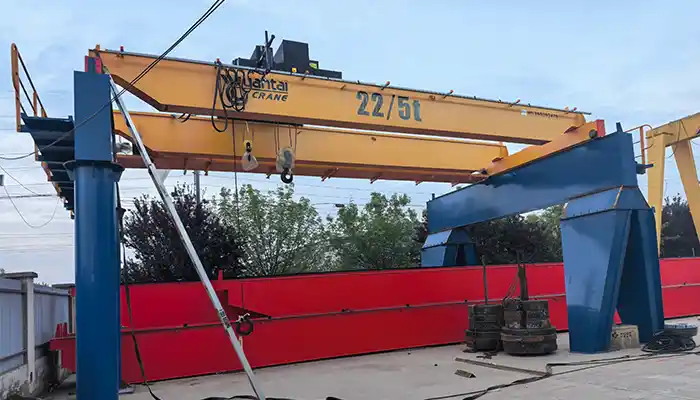
22/5 Ton Overhead Crane Double Hook System: Robust double girder crane with 22-ton main and 5-ton auxiliary hooks for heavy lifting. Get double hook crane!
Free consultation to Confirm Parameters & Specifications and Get
Latest Crane Price & Crane Rate.
- Types of overhead cranes : _______?
- Optional: Overhead travelling crane, goliath gantry crane,Slewing jib crane, Single girder or double girder crane,small portable crane or kbk crane, etc.
- Capacity of overhead crane: _______?
- Optional: 0.25ton, 0.5 ton, 1 ton, 2 ton, 3ton, 5 ton, 10 ton,15ton, 20ton, 25 ton, 30ton,35ton, up to 550ton, etc.
- Crane span & lifting height : _______?
- Crane travelling length : _____?
- Control of overhead crane:_______?
- Optional: pendant/ remote/cabin control
- Voltage supply of overhead crane:_____?
- Eg,: 380V50/60HZ,3Phase or others,etc.
- Application/usage of crane:_______?
- Eg,: Steel mill, ,injection mold, cement,stone, concrete,granite, general manufacturing, etc.
Just leave a message via the contact form and our hoist and crane engineer will contact you with in 24working hours.
Get In Touch
